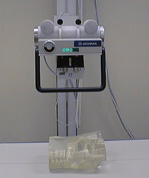
What is Radiography?
On Nov. 8, 1895, German physicist Wilhelm Roentgen made a discovery that would forever change the practice of medicine. While passing high voltage through a large vacuum tube, he noticed that a screen coated with a fluorescent material (for a different experiment) was glowing from the shadows of his work bench in the darkened laboratory.
Roentgen recognized the fact that a peculiar kind of energy, previously unidentified, had penetrated the glass tube, excited the material of the screen, and caused it to glow. That discovery won him a Nobel prize.
The radiograph of the human skull (shown at left) was taken using the conventional method discovered over 100 years ago. X-rays, created in the x-ray tube, pass through the body part and strike a photographic film. The film is loaded in a cassette, between two fluorescent screens. The screens glow when x-rays strike them, and expose the film in the same manner as all photographic film is exposed.

More than 100 years later, Roentgenology (now called radiology or radiologic science) has come into the computer age. When the millennium turned, digital radiography had found its place in radiographic imaging. The first image of the interior of the human body that Roentgen made was a radiograph of his wife's hand. Today, a radiograph (commonly, but wrongly, called an x-ray) is still the best and least expensive method to demonstrate a fracture of a bone or dislocation of a joint. The 20th-Century difference is that images once taken exclusively on film are often stored in computer memory and transmitted via the Internet.
This standard x-ray tube and table (shown at right) is one of nine fully functional, energized x-ray units in Oregon Tech's radiography labs. Below the tube is a phantom of a pelvis and the lower part of the spine. Phantoms are real-bone skeletal parts encased in resin. Students must adjust the settings on the x-ray control panel, the same as would be used for a person, when radiographing the phantoms.






